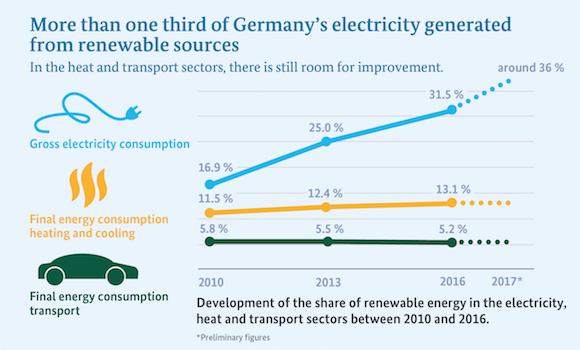Share of renewables in electricity generation reaches new record high
In 2017, the share or renewable energy in gross electricity generation climbed to a new record high, reaching 36 per cent. Wind energy is being expanded particularly fast.
 © Data from the Federal Ministry for Economic Affairs and Energy based on AGEE Stat (last updated in December 2017)
© Data from the Federal Ministry for Economic Affairs and Energy based on AGEE Stat (last updated in December 2017)
Renewable energy has developed into a very important source for generating electricity. According to updated figures presented by the Working Group on Renewable Energy Statistics (AGEE-Stat), renewables reached 31.5 per cent of gross electricity consumption in 2016, with almost one in three kilowatt-hours coming from wind, solar and other sources of renewable energy. Preliminary figures for 2017 suggest that the share of renewables in electricity consumption will continue to grow to reach roughly 36 per cent. This would be more than a 100-per cent increase over 2010 when the share of renewables stood at only 16.9 per cent.
Expansion and better utilisation of renewables installations
In 2016, around 188 terawatt-hours of renewables-based electricity were generated. In 2017, this figure rose to around 216 terawatt-hours – a considerable increase (of around 15 per cent) over the previous year.
Wind energy generation in particular saw a strong increase: this was because onshore wind energy capacity was considerably expanded in 2017 – by around 5 gigawatts according to preliminary figures. This, combined with strong winds throughout the year led to a new record being reached on wind power generation. In addition to this, the amount of electricity generated from photovoltaic installations also rose by just under 5 per cent year-on-year.
Renewables in the heat and transport sectors
In the heat sector, the share of renewables-based systems such as solar thermal installations, pellet heating systems and heat pumps also considerably increased, rising from 11.5 percent in 2010 to 13.1 per cent in 2016. One in three new homes is fitted with a heat pump. This development has been driven forward largely by the funding provided under the Federal Ministry for Economic Affairs and Energy’s Market Incentive Programme (MAP; in German only).
In the transport sector, the share of renewables decreased between 2010 and 2016, falling from 5.8 to 5.2 per cent. Of this 5.2 percentage points, biodiesel and bioethanol contributed 4.5 percentage points, making them the most important sources of renewable energy in the transport sector in 2016. The underlying reason for the decline in renewables in the transport sector is that total energy consumption in this sector is rising as both passenger and goods transport volumes increase. The level of renewable energy used in the transport sector is governed largely by the provisions set out in the Biofuel Quota Act. The Electric Mobility Strategy and the purchase premium for electric vehicles introduced in 2016 are to help expand the use of renewable energy in the transport sector.
Outlook
In 2017, Germany had already achieved its goal of a share of at least 35 per cent of renewable energy in gross electricity consumption by 2020 (according to preliminary figures). The country is also on track for meeting its 2025 goal earlier than planned, which is to reach a share of 40 to 45 per cent. As set out in the Renewable Energies Heat Act, the share of renewables in total heat and cooling consumption is to rise by 14 per cent by 2020. The EU has set the share of renewable energy in final energy consumption to be achieved in the transport sector at 10 per cent (calculated based on the provisions set out in EU Directive 2009/28/EC).
The updated figures provided up until 2016 have been taken from the Federal Ministry for Economic Affairs and Energy’s Renewable Energy Sources in Figures publication, which is published once per year. More detailed data on electricity, heat and fuel consumption in 2017 are to be published by the Working Group on Renewable Energy - Statistics this March.

